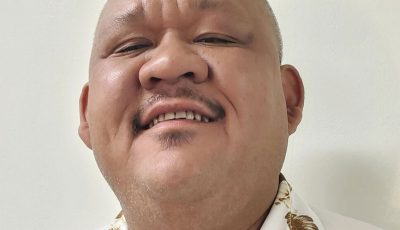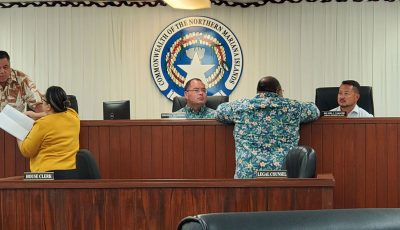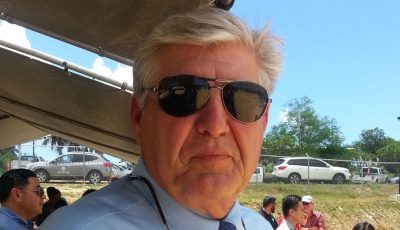‘Status of CW bill’
Editor’s Note: The following is the complete text of the remarks the author gave to the Saipan Chamber of Commerce’s general membership meeting last Wednesday, May 2, 2018.
Thank you for the invitation to speak today.
I am quite sure that what you want to hear about is the status of the Northern Mariana Islands U.S. Workforce Act. So I will not keep you in suspense.
As you already know, the bill passed the Senate last Monday evening by unanimous consent. It was transmitted to the House on Tuesday. And it has been “held at the desk” in the House, which means that it can be acted on at any time.
Just last Friday, I spoke to a majority leadership member, and he assured me that the House will act on the U.S. Workforce Act after we return to Washington next week.
And, like Sen. [Lisa] Murkowski, I am reasonably confident that the President will sign when he receives it.
Last year the President signed the Northern Marianas Economic Expansion Act, which also raised the number of CW permits and was a precursor to the U.S. Workforce Act, 11 days after he received it.
I know every day is precious to those of you who depend on CW workers and who may already have had applications for fiscal year 2019 rejected. Once the U.S. Workforce Act is signed into law, you will have an opportunity to reapply.
And instead of 4,999 CW permits—the number that the Trump administration decided on—there will be 13,000 permits available for next year—the number that Congress decided on. 13,000 is one more permit than we had in fiscal year 2016, when we had a big enough labor force that GDP rose 29 percent.
So, although there were calls for 15,000 CW permits, or the 18,000 I advocated for, the 13,000 we are getting should be enough to keep our economy growing—particularly because the movers behind the large construction projects are finally starting to understand how to get H2 visas and not use up the CW permits, which are so precious to so many of your businesses.
I will say, too, that we are fortunate to have 13,000 permits as the reset number for the CW program. In fact, it was not until the afternoon of Jan. 18 — the day before Sen. Murkowski and I introduced the U.S. Workforce Act in the Senate and the House—that I was able to negotiate the number up from 12,000 to 13,000.
I had to compromise.
There were many similar “nail-biter” moments in the process of negotiating the U.S. Workforce Act.
Of course, we started from zero: no extension, no more CW workers after 2019. Because Chairman Murkowski had insisted on taking away the authority of the Secretary of Labor to extend the CW program beyond 2019, when we got the five-year extension passed in 2014.
She would only agree to the 2014 extension, which included the bar on claims of asylum, which is what makes parole-based tourism from China possible, in return for taking away the ability of the Secretary of Labor to extend the CW program past 2019.
That was a tough choice. But I chose five more years of Chinese tourism. So I rolled the dice on getting the CW program extended by Congress. I had to compromise.
We are not quite there yet. But I think I made the right choice in 2014. In fiscal year 2017, we had 229,389 Chinese tourist arrivals. Without the extension of the bar on claims of asylum that I got in 2014 the only way Chinese tourists would be coming to the Marianas would be with B visas.
And with a B visa a Chinese tourist can go to Hawaii, or California, or anywhere in the United States. With parole they can only come here. So, I think I made the right choice for the Marianas by protecting parole.
Another critically important decision was to request the Government Accountability Office, GAO, to report on foreign labor in the Marianas. In 2016, Sen. Murkowski, Sen. Cantwell, and I jointly asked GAO to stretch the scope of its regular report to Congress on minimum wage to include analysis of how U.S. immigration law impacted the Marianas economy.
That report came out in May 2017 and famously concluded that, without foreign labor, the Marianas economy would shrink by 26 to 62 percent.
That report changed some minds. But not about extending the CW program past 2019. No, when the report came out in May 2017, it was only enough to convince certain Members of Congress that maybe it would be okay to give the Marianas a few more workers in 2017.
That is how I got the Northern Marianas Economic Expansion Act passed in Congress and signed into law in August of 2017.
The complaint at the time, here in the Marianas, was that the Economic Expansion Act was just a “short-term” measure. Of course, that’s not true. Because the increased fee for training local workers to replace foreign workers contained in the Economic Expansion Act continues to this day.
And it was that shift in focus from, “How many foreign workers do we need?” to “How many U.S. workers can we find and train to fill the needs of the Marianas economy?”—that helped to break the logjam over extending the CW program past 2019. People who had been saying, “No extension, no way”—now agreed to sit down and talk about the economic realities of the Marianas.
In September 2017, the bicameral, bipartisan working group formed. Two months later, the Marianas congressional office wrote the first working draft of the U.S. Workforce Act. Two months after that, Sen. Murkowski and I introduced the bill.
Even though we both introduced the bill in the House and the Senate, our strategy from the first days of the working group in September was to make this a Republican bill and pass it in the Senate first.
A Republican bill, because this is a Republican Congress and we have a Republican President. So let’s recognize reality. And let’s start in the Senate, because long experience in Congress has taught me that it’s easier to pass a Senate bill in the House than the other way around.
I passed a bill conveying submerged lands to the Marianas three times in the House. Three times it died in the Senate. It wasn’t until I went to Ron Wyden, who chaired the Senate Energy and Natural Resources Committee, as Sen. Murkowski does now, and asked him to introduce a submerged lands bill that we got it through the Senate and then through the House and signed by the President.
So, I have learned from experience: it does not matter whose name is on the bill. What matters is getting what you want enacted into law.
Today, I think we are close to getting what we want enacted into law.
The Northern Mariana Islands U.S. Workforce Act extends the transition period to 2029. Note: I said the transition period. That means not just the CW program, but the E2C investor visa too, and the exemption from the national cap on H visas—so we can have as many construction workers as we want.
The 10-year extension of the transition period, also, continues the bar on claims of asylum, which makes the parole system for Chinese tourists possible.
At least, until the Trump administration decides to kill parole—a very real possibility.
The U.S. Workforce Act additionally includes a specific, numerical wind-down of the CW program. For 2019, we will have 13,000 CW permits. Five years later in 2024, we will have 10,500 permits. That is more than we have this year.
Let me repeat that: five years from now, we will still have more CW permits than we have today.
Also in the bill, for local workers, there are new protections from competition from cheaper foreign labor. For your businesses, there are new protections from the companies that scoop up hundreds of CW permits and then do not use them.
And, if you have long-term CW workers, legacy workers, you will be able to get three-year permits for them. So, you won’t have to worry every year about renewals and go through the hassle of applying every year to USCIS.
You will also get preferential treatment in applying to renew those three-year permits. And, unlike regular CW workers, your legacy workers will not have to go home every two years. They can stay here—at least until 2029.
Like any legislation, the Northern Mariana Islands U.S. Workforce Act does not have everything that everyone wanted. It is a product of negotiation. We all had to compromise.
But the Workforce Act does have the most important things that we all wanted: an extension of the CW program, more CW permits, better protections for local workers, and better protections for your businesses.
And as Sen. John McCain said in his new book, “You’re damn right, I’m a champion of compromise.”
It’s a good bill. But it is not the law yet.
Last week Monday, I spent all morning, and a good portion of the afternoon, fielding calls from Senate Democrats. They all wanted to know one thing: whether I supported this bill. And I said, “Yes.” So they agreed to support it, too.
Getting the bill passed by the House is what I will be working on next week.
And then—there’s the President.
Thank you again for inviting me to update you.



























